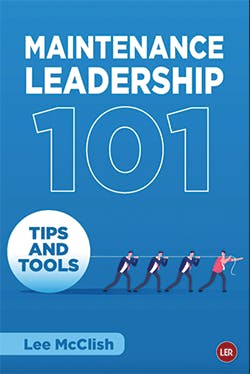While reading Lee McClish’s book Maintenance Leadership 101, I was often reminded of a quote on leadership from former U.S. Secretary of State Colin Powell: “Leadership is solving problems. The day soldiers stop bringing you their problems is the day you have stopped leading them. They have either lost confidence that you can help or concluded that you do not care. Either case is a failure of leadership.”
Looking for other great content to read? Reliable Reading will review stellar books on the maintenance and reliability industry, leadership and management practices, and anything that relates to professionals in our industry.
McClish’s new book approaches maintenance leadership from this same problem-solving direction. The book is targeted at the industry professional who knows that things can be better at their facility, but are not sure where to start making improvements. In fact McClish openly states that his book is designed to cover many of the things he wishes he had known about when he started in maintenance supervision and plant engineering. As such, this book surveys the tactics available to maintenance managers who want to help both themselves and their teams “gain control of the work” and start moving toward more proactive maintenance modes.
For this book, McClish draws on his 25+ years of industrial maintenance experience at companies including NTT Global Data Centers, BASF, and Graphic Packaging International. From the outset of the book, he emphasizes the importance of listening to other team members as a core leadership skill before you make any moves to change the current ways of doing things: “The craftspeople on my team have witnessed my advocacy for their concerns and feedback on design/build and have seen the results of their ideas in action.”
Regardless of your level of authority, McClish adds, “when your people realize the great programs you are establishing, your focus on improving their skills, on improving equipment reliability, and the evidence of the improvements, they will become your agents in reducing machinery downtime and improving the process.” From there, he says, you start with what you can control in your department and then extend it outward to the plant.
Maintenance Leadership 101 is organized into three sections: Foundations, Process, and Continuous Improvement, with the bulk of the book focused on Process. The very first chapter summarizes the characteristics of a world-class supervisor; however, this book is focused less about self-development as a leader and more on the ways that a single person can lead cultural change at his or her facility.
Chapter 2 moves directly into what world-class maintenance looks like, and Chapter 3 maps out the path to move from a culture of reactivity to maintenance excellence. Both of these chapters benefit from the inclusion of thorough checklists, especially Chapter 2, which offers individual lists for areas such as maintenance software, preventive maintenance, predictive maintenance, staffing/resourcing, training, and spare parts/inventory.
Each item on a checklist represents an area where engaged maintenance leaders can choose to direct the attention of their teams. And Chapter 3 offers the invaluable advice, “a leader’s first step toward maintenance excellence is ensuring your boss is onboard with your planned changes.”
From that point on, McClish takes a series of deeper dives into a wide range of maintenance areas, from safety and training to skills assessments and TPM. Each chapter offers both motivational tips as well as practical step-by-step guidance on how to work toward world-class maintenance in the areas you choose to focus on, and will reward the reader who only has time to dip into chapters of immediate interest. However, as someone who read the book front-to-back, I was struck by two themes that ran throughout the entire book: (1) the importance to maintenance success of being organized; and (2) the difference that a CMMS system can make in helping you get organized and stay organized.
The first sentence of Chapter 5, Organization, lays out what is at stake: “the department will be as organized as you are.” If there is a single place to start your improvement initiatives, it is here, as there is no way you will be able to implement positive change without having your own areas of responsibility organized first. McClish identifies three particular areas of organization: records and drawings, standardized work processes, and lines of communication both within your team and with other teams (i.e., production/operations, EHS, C-suite).
However, McClish is also clear about the value that a CMMS/EAM system can bring to getting and staying organized. He devotes an entire chapter on CMMS, stating that “it is extremely difficult to run an efficient maintenance department without a good CMMS program. … It contains work orders, preventative maintenance tasks, inventory, asset history, and possibly purchasing.” This idea links back to McClish’s theme of gaining control of the work; in this case, the CMMS helps you take all the tribal process knowledge you and your colleagues keep in your heads, and move it into one centralized location. An up-to-date CMMS also can support improved planning and scheduling initiatives by keeping work plans and resourcing data standardized and up to date.
Another key area of organization is the storeroom. As McClish puts it, “the storeroom can make or break you,” and this is something many people have felt acutely for the past two years. McClish covers both storeroom setup and stocking, and makes the point that cycle counting is a must to maintain somewhat accurate inventory counts, a task that can be eased by making sure cycle count data are included in your CMMS.
Finally, McClish mentions that “one area I always struggled with was ready to run electronic spares. Invariably, a rebuilt PLC, drive, or circuit board would be installed and wouldn’t work,” so sure enough he reproduces the procedure he developed to test spare electronics on a planned basis. It’s this kind of detail that enables Maintenance Leadership 101 to deliver value in every chapter.
Finally, I was curious on what McClish would have to say on the relationship between maintenance teams and operations/production, as there can be great potential for these two teams to butt heads without effective leadership and communication. He includes a chapter on TPM that addresses operator care responsibilities; however, the bulk of his thoughts on this topic are found in Chapter 8, Preventive Maintenance, where he indicates that your PM program is only successful when there is good cooperation between maintenance teams and operators:
“Communicate to the production team several days to a week before the PM what corrective work orders you are planning so they have the opportunity to add to the list before the day of the PM, this allowing proper planning,” he writes. “A pre-PM brief is necessary at the start of the PM to ensure production personnel understand what corrective maintenance is planned and to allow them to inform you of problems that have occurred during the last 24 hours. A post-PM meeting is effective so production knows what was worked on and to look for issues occurring when the machine starts back up.”
One final note is that McClish is clear that there are no quick fixes when it comes to world-class maintenance. “Don’t expect to create a new PM program in a week or two,” he writes. If you try to tackle everything “at the same time, you probably will not succeed within your desired time frame.”
In sum, this book is highly recommended for any maintenance professional who is interested in leading cultural change, and the series of checklists and team-assessment tools will be useful to both newer workers and veterans.
Maintenance Leadership 101: Tips and Tools is available from ReliabilityWeb.com and Amazon.com.
This story originally appeared in the March 2022 issue of Plant Services. Subscribe to Plant Services here.



